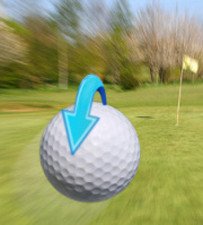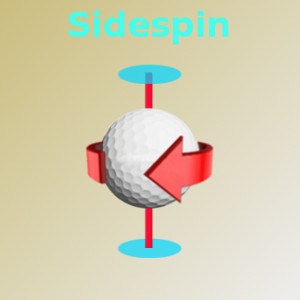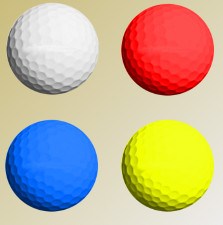
FEMALE GOLFERS USE DIFFERENT CLUBS THAN THEIR MALE COUNTERPARTS, which makes sense when you consider the physical differences. But what about golf balls? Unlike clubs (and people), they're all the same size.
Is there any real advantage to playing a ball that's specifically geared toward a woman's game?
Most manufacturers say yes. Callaway, Nike and Srixon are among those who make women's golf ball models. On the other hand, heavyweights TaylorMade and Titleist do not. In fact, the latter company proudly boasts, “Every Titleist golf ball is designed for women. The golf ball doesn't know who is hitting it.”
Hard to argue with that. Of course, Titleist is pretty much out there on its own with this statement: “Ball fitting for swing speed is a myth.”

Maybe they're right, maybe they're wrong. But the general consensus is that golfers with slower swing speeds drive farther when using a low-compression ball vs. one with high compression. Hence, most amateurs are advised not to play so-called “tour” category balls, like the Titleist ProV1 or Bridgestone Tour B330, unless they swing the driver at least 105 mph. Very few women amateurs can achieve such speed, with most averaging in the 60 – 75 mph range (about one-third slower than the average male).
The bottom line on compression: Playing a lower-compression ball is unlikely to hurt your game, and it may well help. Any ball labeled “Lady's” or “Women's” should fit the bill, while men's models like the Wilson Staff Zip and DUO, Bridgestone e6 and Titleist NXT Tour S offer similar qualities.

That said, even the perfect ball for your swing speed isn't likely to add more than a few yards to your tee shots. So what else should women look for when choosing a golf ball? Here's a brief checklist.
1. Short game control: While many golfers (especially men) obsess over their driving distance, far more shots are taken within 50 yards of the hole than off the tee. Therefore, a ball that delivers optimum spin around the greens improves your chances of getting your chips, pitches and bunker shots close to the hole.
Balls with urethane covers and multi-layer construction typically offer the most greenside spin, but also tend to be more expensive and higher in compression. Most women's models feature thin surlyn covers and two-piece construction, but still deliver adequate or better spin.

2. Approach shot stopping power: A ball that performs well around the greens is likely to excel in this category, too. Since women typically hit their shots lower and with less spin than men, it's crucial that the ball delivers enough backspin to stop quickly when it hits the green.
3. High trajectory: The slower your swing, the more difficult it is to get your drives and approach shots up in the air. A higher ball flight can increase your distance and control. Research which balls (women's or men's) generate a lofty trajectory; this is often a function of specially designed dimples and dimple patterns.

4. Feel: This is the most subjective criteria in ball selection, but it can have a big impact on how you play. Some golfers like an extremely soft feeling ball, while others prefer a firmer sensation at impact. Playing a ball that feels “right” can inspire confidence – and we all know how important that is on the golf course.
5. Accuracy: With their slower swing speeds, women are less prone to hit shots wildly off line (i.e. big hooks or slices). Still, it's best to play a ball that reduces sidespin and enhances accuracy.
6. Color: You may think this criteria would be strictly a matter of taste, too. But brightly colored balls are not only easier to find in different light conditions, rough and woods, many golfers are better able to follow the flight of a colored ball. Different companies offer different options, including yellow, orange, green and, yes, pink.
Different companies offer different options, including yellow, orange, green and, yes, pink.
7. Price: Most women's golf ball models are priced at $20 or less per dozen, making them a relative bargain. (Men's versions comprise a much wider range, anywhere from $10 - $50 a dozen.) Women tend to lose fewer golf balls and abuse them less, getting more bang for the buck from each pack. Obviously, only you can decide how much you're willing to spend.
Since virtually every ball on the market claims to boost driving distance, deliver greenside control and approach-shot spin, fly straight as an arrow and feel better than a Swedish massage, your best bet is to read first-person reviews, seek opinions from your fellow golfers and, most importantly, try different models to find the one that works best with your swing.
Happy hunting, ladies.

Women's Golf Balls – How to Choose the Right One for You
The ball you choose to use on the course is one of the most important equipment decisions you will make in this game. Most golfers think about equipment as being the clubs they use, and that is certainly an important piece of the equation as well. But you only get to use one type of ball, so you need to make sure that it is a good fit for your abilities. Only when you have the right ball, along with the right clubs and other pieces of gear, will you be able to rise to meet your potential on the course.
For women, the process of picking a golf ball is the same as it is for men. The goal is to find a ball which has the right characteristics to bring out the best in your game – while minimizing your faults. Sometimes, that will mean picking a ball which is marketed specifically toward women. In other cases, it will actually mean using a men's ball. It doesn't really matter if a ball is marketed as a 'men's' or 'women's' model – the only thing that matters is how it performs.
In general terms, women's golf balls are going to feature a softer design which is easier to compress at impact. This is because, on average, women have lower swing speeds than men. With a softer ball, it will be easier to create the compression necessary at impact to get the ball up in the air and moving toward the target. Also, these golf balls make it easier to create spin, which is a helpful feature when you don't have the raw power and swing speed to do the job.
It is extremely important to point out, however, that these golf balls are simply designed on averages. The golf equipment companies determine an average profile of a female player, and they then create a golf ball which will work for that player. In the end, this ball may or may not be right for you. If you are a particularly powerful player, you may need to head into the men's golf ball section to find a model that is going to perform well in your game. It is possible that you will fall nicely into the average range when looking for a golf ball, but don't assume that to be the case. Only when you take the time to test out various golf balls will you know for sure which one is going to suit you best.
In this article, we are going to talk about some methods you can use to find the right golf ball. It will take a little bit of time to find the right ball, but your effort is going to be rewarded in the end. Once you find a ball you like, do what you can to stick with that ball for as many future rounds as possible. It is a great thing to have comfort and familiarity with your golf ball, but you will never have that if you are constantly switching models.
All of the content below is based on a right-handed golfer. If you happen to play left-handed, please take a moment to reverse the directions as necessary.

Understanding Ideal Performance
Before you can go shopping for a golf ball, and before you start testing various models, you need to know what it is that a golf ball should do for your game. In other words, how do you know when you have found the right one? If you don't know what you are looking for, it will be nearly impossible to find it.
The points below highlight exactly what your next golf ball should do for you on the course.
- Allows you to play your game. This is the most important point on the list. Rather than having to suit your game to the abilities of the golf ball, the ball itself should naturally be well-suited to what you want to do. For example, if you like to play high shots into the green, the ball should allow for enough spin to do just that. If you feel like you are constantly 'fighting' the ball to make it do the right thing at the right time, you don't have the right ball in your bag. Tailoring your abilities to match up with the ball is simply not a good idea. Your golf ball search will be over when you find a model that feels like it was designed specifically for you personally.
- Makes up for some of your deficiencies. As golfers, we all have shortcomings. That is nothing to be ashamed of, as this is one of the hardest games in the world. If you think for a moment, you will probably be able to identify at least a couple parts of your game which could use some improvement. While you are working on making those improvements, you should consider using a ball that is going to help cover them up. A great example of this is a player who tends to produce too much sidespin off the tee. If you are frequently slicing your drives off to the right, finding a golf ball with a relatively low spin rate can help tremendously. Many amateur golfers pick high-spin golf balls because that's what the pros use, but this is a costly mistake. Unless you can control your spin precisely, you should stick with a lower spin ball that will help you stay in the fairway.
- Fits in your budget. It would be a mistake to overlook this point. You probably have a set amount of money in mind that you are willing to spend on your golf game. If you find a golf ball that you simply can't fit in your budget, it won't work regardless of how well it might perform on the course. At the start of this process, identify a price point as a limit for your ball search and then only consider models under that number. Golf can be an expensive game, and you aren't going to have much fun on the course if all you can think about is how much money you have spent on your gear.
- Feels right on the greens. You don't want to forget about the short game when picking out a golf ball. Sure, it is fun to test new golf balls with your driver to see how far they will fly, but the short game is where you can really save strokes. In this area of the game, picking out a golf ball is more about feel than anything else. You can throw the objective measures out the window at this point and simply decide how each ball feels when it comes off your putter face. Do your best to find a ball that feels great in the short game while also performing properly with your long clubs.
Picking the right golf ball is something that can seem a bit intimidating at first. However, once you get into the process, you will find that most of the models eliminate themselves pretty quickly. Maybe a certain ball just doesn't feel right on the greens, or maybe it flies much too high off your driver. Whatever the case, you should be able to cut down on the list of options in short order. In the end, it will probably come down to two or three potential models vying for your business. At that point, you can really dive into the details to determine which one should come out on top.

Going High-Tech
Golf has changed tremendously in recent years. While it still remains a traditional, old-fashioned game in the eyes of many, golf has adopted a great deal of modern technology. Most of that technology, not surprisingly, has entered the game in the form of equipment. Modern drivers look nothing like the drivers of old, and iron sets have been revolutionized as well. Although the golf ball looks the same as it has for decades, don't be fooled by appearances – the ball is quite different these days as well.
Not only is the construction of the modern golf ball a result if plenty of technology, there is also technology involved when it comes to picking the right ball for your game. Specifically, you can use a fitting at your local golf course to determine which ball will be best for your needs. Many golf facilities now offer these kinds of fittings, so simply making a few phone calls to local golf courses and driving ranges should reveal plenty of options.
If you do decide to go through with a ball fitting at a local golf facility, keep the following tips in mind.
- Be yourself. The worst thing you can do during a ball fitting is to try to impress the machine, or the professional who is running it. Many golfers try to swing their hardest when hitting shots on a launch monitor, hoping to put up the highest possible swing speed or estimated distance. Unfortunately, this can badly skew the results of the process. If you don't use your normal swing, the results of the ball fitting aren't going to be useful when you head back out onto the course. Forget about impressing anyone and just stick to your usual game. This should be all about you and improving your own game – not trying to make an impression on the club pro.
- Ask questions, but also listen. There is a tendency among amateur golfers to be a little strong-headed when it comes to their equipment. For instance, many players will insist that they know what is best, despite the fact that they are paying the professional for his or her time. That is silly. When you go into a ball fitting session, do so with an open mind and a willingness to listen to the advice and feedback you receive. It is great to ask questions, of course, but you need to be open to the answers – even if they aren't what you expected to hear. Refusing to listen to the advice you are being offered is just a waste of everyone's time.
- Combine the technical with your own feel. Before you 'officially' select a golf ball that you are going to make your full-time ball of choice, be sure to test a few models on the course. Think about it this way – the ball fitting process should be used to narrow down your list of choice to just two or three contenders, and you should then test those options on the course until you are sure of the winner. While technology is great for helping you find the right range of balls to consider, it can't tell you how the ball will feel coming off the club, or what kind of confidence it will give you before the shot. Bringing together traditional feel with high-tech input is the best way to find an appropriate golf ball for your game.
Don't stay away from a ball fitting process just because you are nervous about hitting shots in front of a teaching pro. These people are used to working with golfers of all skill levels. You can be sure that the pro has seen plenty of players who are worse than you, and plenty who are better. They aren't going to be judging you for your lack of skills or anything like that – to them, this is just a job, and you are another customer. If you are interested in finding the right ball, set any hesitations to the side and work on setting up a ball fitting session in the near future.






